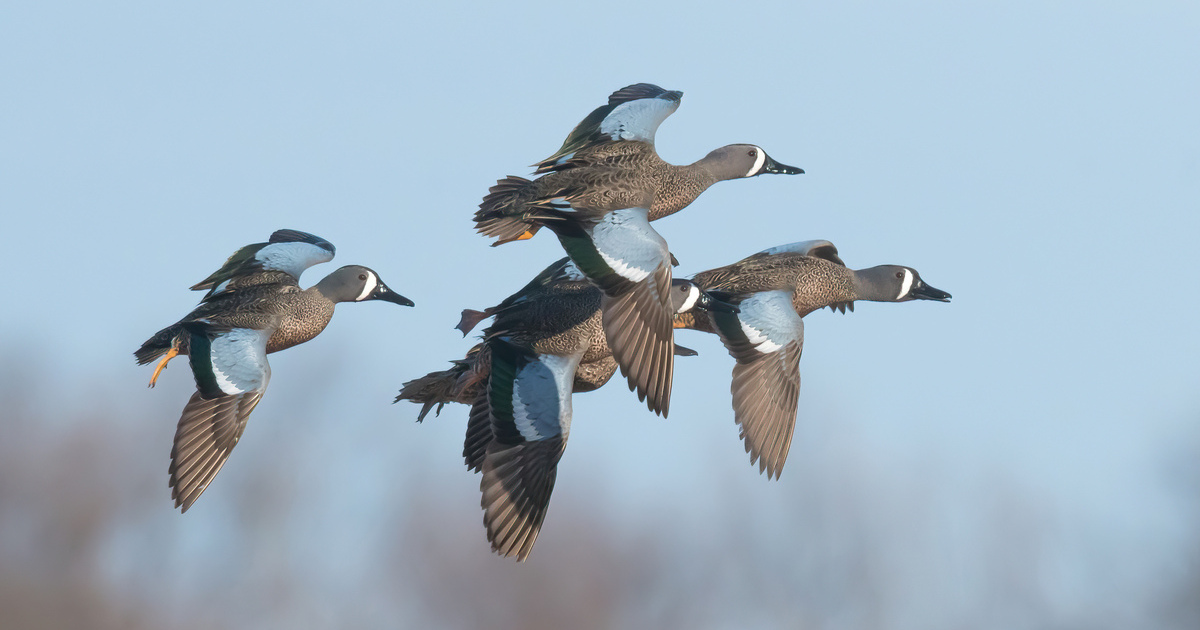September Teal: Mayhem in the Marsh
Learn strategies to maximize your success during the teal season
Learn strategies to maximize your success during the teal season
By Wade Bourne

Imagine taking a handful of stirred-up hornets and throwing them in front of a hunter. This is similar to what the latter faces when a flight of blue-winged teal swarms over his decoys. The main difference is, with the birds he's not in danger of being stung, except perhaps by the embarrassment of empty shell hulls floating on the water with no feathers beside them!
Truly, these little ducks are tricky targets. They come in a darting mass rather than a graceful formation like mallards or pintails. While bigger ducks glide with natural grace, teal scramble like a youth hockey team.
In September, waterfowlers take to marshes, ponds and sloughs to try for these feathered rockets. Bluewings, especially, leave their northern nesting grounds at the first hint of fall, heading toward wintering areas in Mexico and Central America. Most of these birds are long gone by the time later, regular duck seasons open. Thus, the US Fish and Wildlife Service allows a special early teal season in years when the population forecast is abundant for these birds (in excess of 3.3 million) on the breeding grounds.
These seasons are held between September 1 and 30, and season lengths vary by flyway. Some states like Florida, Kentucky, and Tennessee have a five-day special teal and wood duck season. (Check your state game regulations for season length and bag limit in your state.)
This early season is typically a time of sweat-mopping, mosquito-slapping and shell-popping fun. It also offers a preview/tune-up for later seasons when the big ducks arrive. Here's how you can score on the early season fun.
Blue-wings migrate on the leading edge of cold fronts that sweep across the country. Quite literally, one day a marsh or lake may have none of these little birds; the next day, after a front passes, it's covered up.
Good habitat is critical to attracting teal in September. These birds like to feed in very shallow water, and often loaf on mud flats bordering these shallows. Find these areas before opening day, and be there when the season and the little ducks arrival coincide. Watch the weather forecast for any northern cold front activity however slight. When the wind turns out of the north, go hunting the next morning.
Use plenty of decoys to be noticeable to passing birds. Teal decoys are effective on close-flying birds, but mallard decoys will work as well or better, since they are larger and more noticeable from a long distance. One good set would be two dozen mallard decoys (mostly hens) set close to the bank, with another two dozen blue-wing decoys scattered beyond the mallards. Leave an open landing hole 20-30 yards out.
Blue-wings are susceptible to calling when there's not too much shooting. Hens make a sound similar to a five-note call of a mallard hen, except its higher pitched, faster and softer in volume. Call makers sell teal calls that closely imitate these birds calls, and they're good for grabbing passing birds attention.
In September, teal aren't very wary, and blinds don't have to be too sophisticated. Natural on-site vegetation may offer plenty of concealment cattails, buck bushes, willows, etc. In September, such vegetation is in full foliage, offering a good screen from incoming birds. If natural cover is sparse around a watering hole, a hunter might stretch a camo net between poles jammed into the mud. In either case, the main concerns here are to wear full camouflage clothing, hunker down, and remain absolutely still when a flight is coming in.
While teal are fast fliers, they aren't difficult to bring down. Thus, guns/loads for teal hunting should be selected for ease and quickness in swinging and pointing and also for good pattern density.
This is why a 20-gauge might be the ideal gun for blue-wings, especially over small, confined waters. Major shotshell manufacturers offer non-toxic 20-gauge loads in 3-inch and 2 -inch loads in shot sizes from No. 2- No. 7. Size No. 4 is a good median choice. Best choke for small potholes and ponds would be improved cylinder or modified.
A special note should be included about the fine table quality of blue-winged teal. These ducks have a tender consistency and delicate flavor that many consider the best among all waterfowl.
One favorite way to prepare them is to skin freshly bagged birds and grill them on a slow charcoal fire. Before grilling, wash the birds and marinate them at least two hours (cooks preference on the marinade). Then, wrap them with bacon secured with toothpicks. (Slices of jalapeno, onion or mushrooms may be included, if desired.) Place the teal on the fire, and baste every few minutes with barbecue sauce, garlic butter or Italian dressing. The secret to a delicious result is not to overcook the meat. Breasts should be removed from the fire while the meat is still pink and juicy.